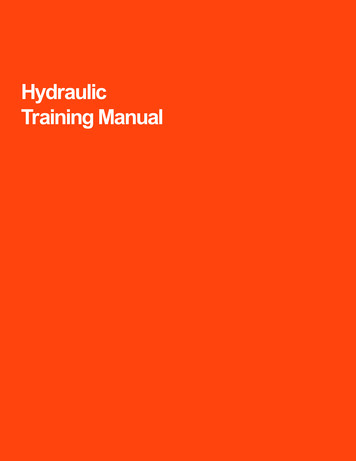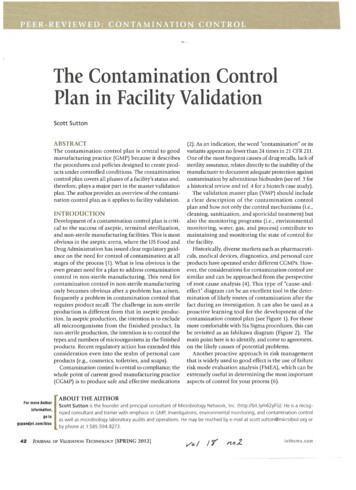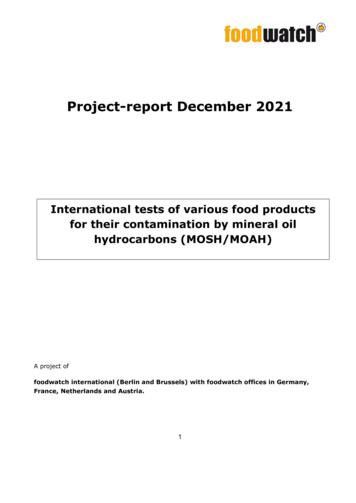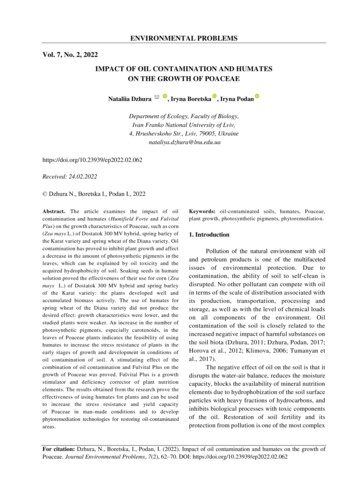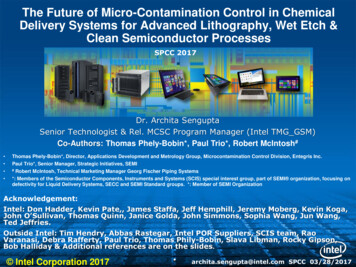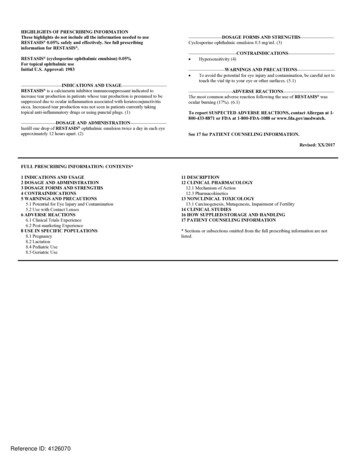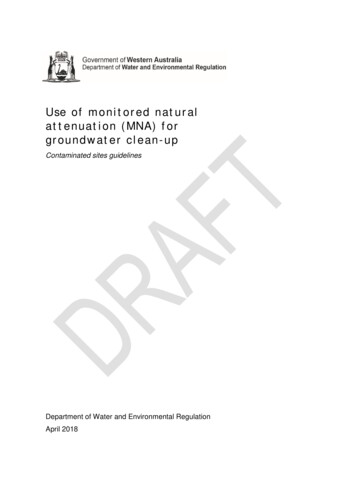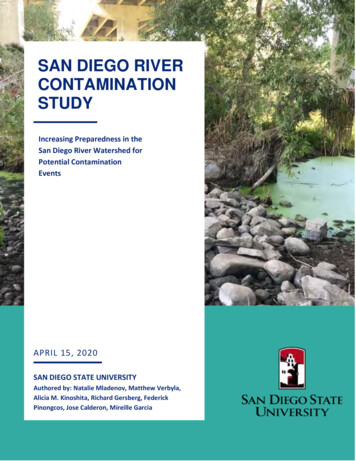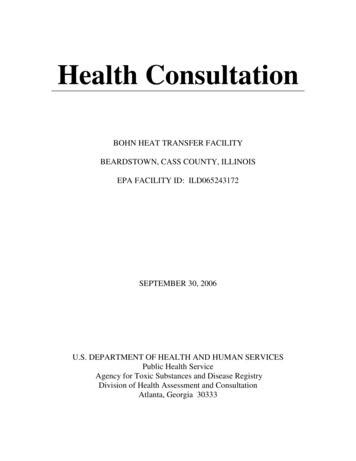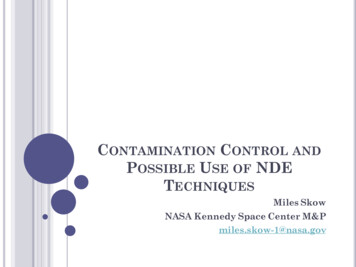
Transcription
CONTAMINATION CONTROL ANDPOSSIBLE USE OF NDETECHNIQUESMiles SkowNASA Kennedy Space Center M&Pmiles.skow-1@nasa.gov
OUTLINEPurpose & Introduction Clean Processing Types of Contamination Cleanliness Levels Airborne Fluid Systems Contamination Inspections Difficult Cases NDE Possibilities Failures Due to Contamination Conclusions 2
PURPOSE Contamination a real worldissueExplain some of thecontamination control processeswhich NASA and otherscommonly go throughIdentify difficult areas in whichNDE methods may be able tohelpInquire of NDE methods andtheir effectiveness in thesecertain areasContamination Control receiving inspection ofthe Mid-Infrared Instrument (MIRI):http://nasa.gov/3
TODAY’S SPACECRAFT Contamination Sensitive Optics Fluid Systems Sensitive DetectorsJames Webb Space Telescope - 2018:http://jwst.nasa.gov/4Orbiting Carbon Observatory (OCO-2) – July2014 http://oco.jpl.nasa.gov/Soil Moisture Active Passive (SMAP) – November 2014https://smap.jpl.nasa.gov/
CLEAN PROCESSING Clean Room ProtocolsGarmenting Air Showers Cleaning Equipment/Tools Restricted Materials Clean Room Airflow cle generatingmaterialsShuttle Payload Change-out Room (PCR):http://www.nasa.gov/mission pages/shuttle/flyout/PCR.html5Clean Room Air altimoresun.com/wpcontent/uploads/2013/07/BS-
CLEAN PROCESSING Processing in Clean Room Assembly/mfgClean as you go practicesFunctional testsInstallation of coversAccess of contained areasFuelingOrion Crew Module Lift and Stack onto Service Module June dj8Hubble Space Telescope Servicing Mission 4 main crewfam fgs full.jpgMars Science Laboratory (MSL) Curiosity Testing in Clean ia13388-640.jpg6
CONTAMINATION Contamination Can be metallic (e.g., stainless or titaniumshaving) or non-metallic (e.g., metallicparticle)Can be from the system itself or introducedfrom external sources (e.g., people, tools,materials used, environment)Other possible contaminants: Image of cotton (left) and polyester (right) fromScanning Electron Microscope (SEM). Source:http://www.lpdlabservices.co.uk/industrial support/cottonand-polyester-sem-im.jpgPlant pollenHairMetal shavingsPencil leadBiologicals (e.g., skin)Paper fibersInsectsCorrosion productsAdhesive from tapeImage of corrosion on lead-tin alloy fromScanning Electron Microscope (SEM). Source:http://media.cleveland.com/science impact/photo/semcorrosionjpg-a22a1d2cf0458b9a.jpg Contamination Definition: Image of pollen taken from ScanningElectron Microscope (SEM). ns/a/a4/Misc pollen.jpgAny unwanted matter thatexceeds maximum allowableswhich could be detrimental to therequired operation, reliability, orperformance of a part, component,subsystem or system.7
CLEANLINESS LEVELS Airborne and surface cleanliness levels vary fromdifferent programs, spacecraft developers, processingfacilities, and so on. For example:NASA Scientific Missions KSC Processing Can be based from ISO/IEST Standards or tailoredcombination.Varies for different missions.Interesting conflict with commercial partners and jointpayload flights.Complications with customers working to outdatedstandards like FED-STD-209.KSC developed standardsLockheed Martin / Orion Tailored standards from ISO standards and IESTstandards8
AIRBORNE CLEANLINESS LEVELS Classification of air cleanliness Airborne requirements vary between customerGeneric example ofCleanroom Classes.Class of 0.5 µm 5.0 µmCleanroomClass 1n/an/aClass 2n/an/aClass 3xxn/aClass 4xxxxxClass 5x,xxxxxxClass 6xx,xxxx,xxxClass 7xxx,xxxxx,xxxClass 8x,xxx,xxx xxx,xxxClass 9 xx,xxx,xxx x,xxx,xxx International Organization for Standards(ISO) has established cleanroom levelswhich are commonly used, however, notnecessarily required by eachprogram/center.Each class has corresponding number ofparticles in a particular size range (µm)per volume (m³ or ft³)Other size ranges available 0.1 µm, 0.2 µm, 1.0 µmAdditional limits can be determined fromequations provided by the associatedspecification9Note: see ISO 14644-1 for actual international standard requirements
PRECISION CLEANLINESS LEVELS Fluid systems like propulsion, environmental and lifesupport may use additional particle count requirements. Generic example of CleanlinessLevels of a Sample/System.Minimum Bin Maximum Bin Cleanliness Level Cleanliness LevelSize (µm)Size (µm)A (# of particles) B (# of 0 Institute of Environmental Sciencesand Technology (IEST) hasestablished cleanliness levels whichare commonly used, however, notnecessarily required by eachprogram/center.Each bin size or range hascorresponding number of particles ina particular size (µm) per area (m² orft²)Other cleanliness levels availableOften a sample is taken fromflushing a system through a filterthen particulate on that filter iscounted and categorized into each binsize / size range.10Note: see IEST-STD-CC1246E for actual international standard requirements
VISUAL CONTAMINATION INSPECTIONS Verification of cleanliness Visual inspection Black light inspections Visual contamination inspection for theSTS-125 Hubble Space Telescope (HST)Servicing Mission 4 (SM4) payload. Source:http://mediaarchive.ksc.nasa.govMost common verification method forouter surfacesCan only be effective on accessible areas(often only line of site areas)More effective when performed in stagesduring assembly (i.e. during hardwarecloseout inspections)Inspecting for organics that cannot beeasily seen with natural light11Black light contamination inspection for the LunarReconnaissance Orbiter (LRO). Source:http://mediaarchive.ksc.nasa.gov
CLEANLINESS OF FLUID LINES Spacecraft propulsion lines andother fluid lines Often hazardous commoditiesRequirements for fluid cleanliness Propulsion tubing precisioncleaned Hazardous fueling of the Mercury Surface,Space Environment, Geochemistry, andRanging (MESSENGER) spacecraft. senger.jhuapl.edu/Verified prior to fillRequires verification of cleanliness12Hazardous fueling of the Orbiting Carbon Observatory (OCO)spacecraft. Source: http://mediaarchive.ksc.nasa.gov ,http://oco.jpl.nasa.gov/
FLUID SYSTEM CLEANLINESS VERIFICATION Fluid sampling to verify cleanliness Flush a system with a compatible or like fluidFlush through a filterCount particles captured on filter Reference size and count requirements (IEST or similar)Use of microscope necessary to count particles Generally, the un-aided human eye can see down to 50 microns withoptimal contrast High # of particles Overlapping particles3 mmsquaresTypical filter used in fluid particlesampling. /media.nl?id 452415&c 1250437&h 1934623c1d147821b2b713Example of stereoscope in use in cleanroom. tent/164057main stardust-0216-025-hires.jpg
EXAMPLE OF EXCURSIONGeneric example of Cleanliness Level.Generic example of FailedCleanliness Level.Minimum Bin Maximum Bin Cleanliness LevelSize (µm)Size (µm)A (# of 0500750075010000100012500Actual Counts (#of particles)1,50015015520000 Example fails as highlighted in redCorrective action: FlushRe-sampleInspect to find source14
DIFFICULT CASES Difficult to Identify Case # 1: Internal Tubing/Lines X-ray Not all components in system can be flushedHow to verify cleanliness in these areas? Statistical analysis based from acquired sample dataExperience from clean processingNDE? X-rayPrimarily used to inspect weldsHas been successfully used to identifymetallic Foreign Object Debris (FOD) Onsite usage has not shown to have theresolution or capability to identify smallparticles ( 200 µm) Non-metallic particles difficult toidentify General x-ray image of a tube. dn650/fig12.jpg15
DIFFICULT CASES Difficult to Identify Case # 2: Borescopes Borescopes typically used for FODdetection and/or retrievalNot typical for highly sensitive systems Borescope Issues Borescope inspection for FOD on theGalaxy Evolution Explorer (GALEX)satellite in 2003. Source:http://mediaarchive.ksc.nasa.gov/Difficult to clean borescopes toneeded cleanliness levelsCannot navigate beyond tight bendsCan transport contaminationfurther into the systemDifficult to capture smallcontamination particles16
DIFFICULT CASES Difficult to Identify Case # 3:Inaccessible Cavities Surface Contamination Identified STS-132 Payload including the MiniResearch Module (MRM) installed intoorbiter Atlantis’ payload bay. Source:http://mediaarchive.ksc.nasa.gov/Not all components/areas canbe easily accessedClosed out areasOuter surface contamination leadsto suspect of internal contaminationof closed out areasSpacecraft already integrated ontolaunch vehicle or similarNDE able to inspect at greater ( 5-10 feet) from suspect area?17
USE OF NDE Need A non-destructive method to inspect Ideal to be able to characterize particles 5µm or greaterMust be able to characterize 25µm or greaterMust be portableMust be able to operate equipment inside a clean environmentnext to flight hardwareNeed to be able to identify both metallic and non-metallicparticles NDE Currently no requirementsnecessitating use of NDENDE would be a useful tool tohelp mitigate decisions andproper corrective actions18Comparison of hair with other contaminants. pm2 5 graphickennislink epa.jpg
FAILURES DUE TO CONTAMINATIONIt is important to protect our spacecraft from contamination. 2014 SpaceX Commercial Re-supplyService 3 (CRS-3) 2011 Russian Soyuz Progress 44 SpaceX CRS-3 Contamination Event. ngmachine-contamination-spacexs-crs-3-dragon/ Failure likely due to contamination inthe fuel lines.Loss of entire vehicle and payload1992 Mars Observer Mars ObserverSoyuz Progress 44 Contaminationcontamination event. Source:Possibility. failurefindings.htmlIdentified contamination which delayedthe launch approximately 2 weeksPayload contamination riskDelay of the launch, and removal of thespacecraft to the preparation facility forcleaningMission subsequently lost for otherreasonsMany other spacecraft contaminationfailures/problems can be found in thereport “Contamination EngineeringDesign Guidelines” by Nancy ntamControl.htm# Toc51137822519
CONCLUSIONS Contamination can cause damage to spacecraft instruments,impact mission goals, and even cause failures or total loss ofmission.Safety measures are taken to protect the spacecraft duringassembly, test, and processing.Areas have been identified which have proven difficult toasses without accepting risk.NDE could be a helpful tool and would need to work with thefollowing limitations:Able to characterize 25µm or greater with the goal of characterizingparticles 5µm or greater Portable system Able to operate inside a cleanroom next to flight hardware Able to identify both metallic and non-metallic particles X-ray and borescope thus far have not proven to be highlyeffective.Lockheed Martin contamination control engineer onsite andwilling to hear possible NDE tools20
CONTAMINATION Contamination Can be metallic (e.g., stainless or titanium shaving) or non-metallic (e.g., metallic particle) Can be from the system itself or introduced from external sources (e.g., people, tools, materials used, environment) Other possible contaminants: Plant pollen
